Raised bed gardening is a beginner-friendly method that allows you to grow your own vegetables and plants at home. With its numerous benefits such as improved soil quality, better drainage, and easier weed and pest management, raised bed gardening is the perfect way for beginners to start their gardening journey.
Creating a raised bed garden involves constructing elevated planting areas that are contained within a border or frame, allowing you to customize the size and shape of your garden based on your preferences. With the right knowledge and techniques, you can enjoy a successful garden and a bountiful harvest.
Key Takeaways:
- Raised bed gardening is an accessible and beginner-friendly method for growing plants and vegetables at home.
- Construct elevated planting areas with various materials and create a balanced soil mix for optimal growing conditions.
- Choose appropriate plants and practice regular watering, mulching, and crop rotation for a healthy and thriving garden.
- Starting small and using appropriate gear is recommended for beginners.
Why Choose Raised Bed Gardening?
Raised bed gardening offers numerous benefits such as improved soil quality, better drainage, and easier weed and pest management. By creating a raised bed, you have more control over the soil composition, allowing you to create a fertile and well-draining environment for your plants. This is particularly advantageous for gardeners who have poor soil quality in their area or for those who have limited access to gardening space. Additionally, raised beds offer better drainage compared to traditional gardens as they are elevated from the ground, preventing soil compaction and allowing excess water to drain away easily.
Weed and pest management also become easier in a raised bed garden as they are contained within a specific area, making it easier to monitor and control any infestations. By using protective covers and companion planting, you can also minimize the number of pests that invade your garden.
Furthermore, raised bed gardening can extend the growing season as the soil in raised beds warms up quicker than the ground soil, allowing you to plant your crops earlier in the season. This is especially beneficial in regions with shorter growing seasons.
Lastly, raised bed gardening is also a more accessible gardening method as raised beds can be built at a height that is comfortable for the gardener, reducing the need for bending or kneeling during planting and maintenance. This makes it ideal for gardeners with physical limitations or for those who prefer a more convenient gardening method.
Getting Started with Raised Bed Gardening
To start a raised bed garden, you need to choose appropriate plants for your climate and select a suitable location. When selecting plants, consider the amount of sun and shade the area receives, as well as the specific needs of each plant. Some popular options for raised bed gardening include tomatoes, peppers, lettuce, and herbs. It’s also important to choose plants that will not outgrow the bed or compete with one another for resources.
When selecting a location for your raised bed garden, choose an area with good drainage and ample sunlight. Avoid placing the bed in a low-lying area that is prone to waterlogging, as this can lead to root rot and other issues. If possible, position your raised bed garden close to a water source to make watering easier.
| Tip: | If you’re short on space, consider a small raised garden bed. These are perfect for patio areas or balconies, and can be used to grow a variety of fruits, vegetables, and herbs. |
|---|
Once you’ve selected your plants and location, it’s time to create your raised beds. Choose materials that are durable, non-toxic, and able to withstand the elements. Many gardeners opt for wood, which is inexpensive and easy to work with. Other options include concrete blocks, metal, or plastic. Whatever material you choose, ensure that the bed is deep enough to accommodate the root systems of your plants.
It’s important to create a well-draining soil mix that is rich in nutrients and organic matter. A typical soil mix for raised beds includes equal parts of compost, garden soil, and vermiculite or perlite. This mixture should be loose and crumbly, with good water retention and drainage capabilities.
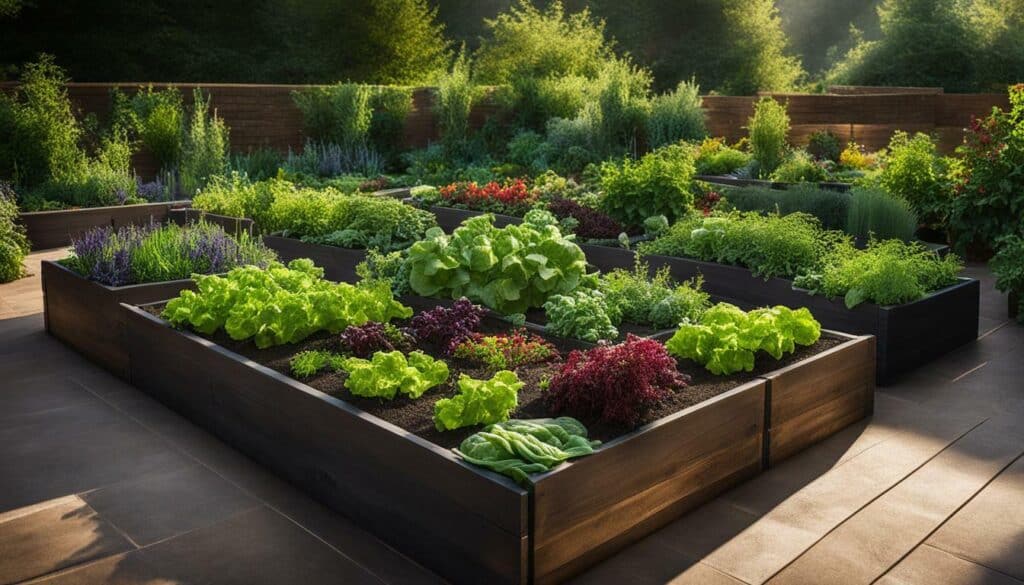
When planning your planting layout, consider the specific needs of each plant. Group plants with similar watering, light, and nutrient requirements together. Use trellises or stakes to support climbing plants like tomatoes or cucumbers, and space your plants according to their mature size.
To maintain a healthy and thriving raised bed garden, it’s important to follow a few key care practices. Regular watering is essential to prevent moisture stress and ensure optimal growth, and mulching can help conserve moisture and suppress weeds. Crop rotation can help prevent diseases and pests, while annual soil amendments with compost and organic matter will help to replenish nutrients and improve soil structure. By following these tips, you can enjoy a bountiful harvest of homegrown fruits and vegetables in no time.
Building the Raised Bed
Building the raised bed can be done with various materials like wood or concrete blocks, and it’s important to create a well-draining soil mix. The materials you choose will depend on your personal preference, budget, and the style of your garden. Wood is a popular choice as it is readily available, affordable, and easy to work with. Cedar and redwood are naturally resistant to decay and insects and are commonly used for raised beds.
Concrete blocks are another option that offers longevity and a contemporary look to your garden design. The blocks can be stacked to any height, and the hollow design allows for the addition of reinforcing steel and concrete. Other options include bricks, stones, and even metal troughs.
Once you have chosen your materials, you will need to create a well-draining soil mix that provides adequate nutrition and moisture for your plants. A good mix for raised bed gardening consists of equal parts garden soil, compost, and coarse sand or perlite. This will ensure that your plants have enough drainage while retaining moisture and nutrients.

When building your raised bed, it’s important to consider the height and width of the bed. The height should be at least 6 inches to allow for proper root growth and moisture retention. The width of the bed should be no more than 4 feet, as this allows you to reach the center of the bed from either side without stepping inside and compacting the soil.
Creating a raised bed can be an enjoyable and rewarding experience for any gardener. By choosing the right materials and soil mix, you can create a healthy growing environment for your plants. With regular maintenance and care, your raised bed garden will provide you with fresh produce all season long.
Caring for Your Raised Bed Garden
Caring for your raised bed garden is essential to ensure the health and productivity of your plants. Raised bed gardening allows you to control the soil composition, improve drainage, and manage weeds and pests, but it also requires ongoing care and attention. To ensure the success of your raised bed garden, you should consider factors such as climate, plant selection, watering, and proper gear.
Watering: Regular watering is crucial for the health of your plants. Watering should be done when the soil has absorbed the water from the previous watering, which may vary depending on your location. Checking the moisture level by touching the soil with your finger can help determine if your garden needs water. Avoid overwatering, as it can drown your plants and cause root rot.
Mulching: Mulching helps retain moisture in the soil, prevent weeds from growing, and regulate soil temperature. Organic mulches, such as straw or leaves, can also add nutrients to the soil as they break down. Apply a layer of mulch to your garden bed, keeping it at least 2-3 inches away from the base of your plants.
Crop Rotation: Crop rotation is the practice of growing different crops in the same area to prevent the buildup of pests and diseases in the soil. This technique can also help improve soil fertility and reduce the need for fertilizers. Plan your crop rotation based on the type of plants you are growing and their nutrient requirements.
When caring for your raised bed garden, make sure to wear proper gear, such as a good hand trowel and quality shears. The quality of the soil is crucial, and you can find quality garden soil from most garden centers or local nurseries. You can start your raised bed garden in containers or by building your own raised garden beds. Regular watering, mulching, crop rotation, and soil maintenance are essential for the ongoing care of your raised bed garden.
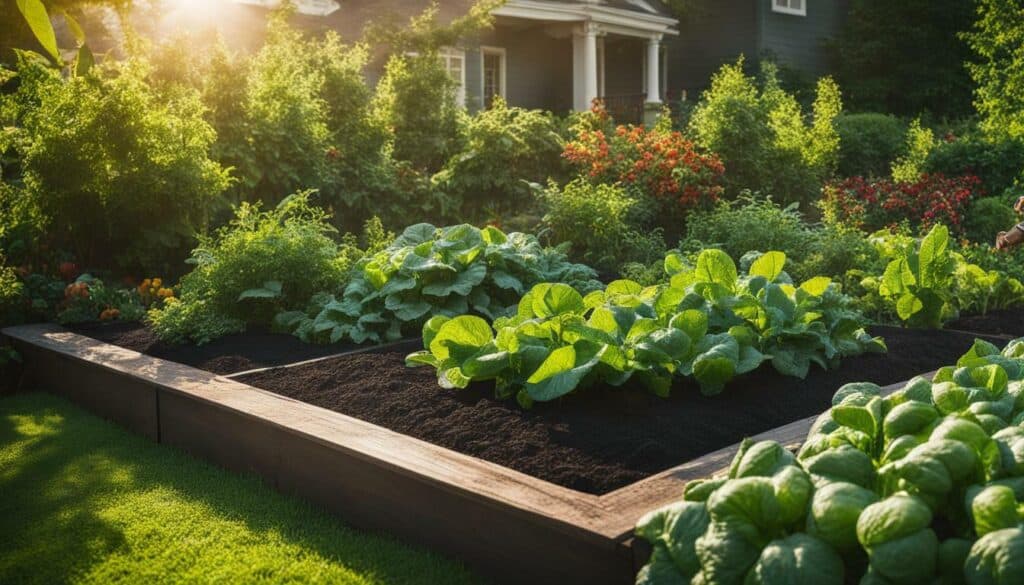
By following these tips and taking care of your raised bed garden, you can enjoy the therapeutic, rewarding, and calming experience of growing your own plants. With a little effort and patience, you can have a beautiful and productive garden that provides you with fresh and healthy produce all season long.
Maximizing Yield in a Small Space
Even with a small raised garden bed, you can maximize your yield with the right techniques. Raised bed vegetable gardens are a great option for those with limited space. The confined area allows you to focus on fewer plants, making it easier to maintain and manage your garden. As a result, you can produce more crops than you would in a larger traditional garden.
When planning a small raised garden bed, it’s important to consider the plants you want to grow and their spacing requirements. Some plants, such as tomatoes and peppers, require more space than others. You can maximize the use of your space by planting smaller plants in between larger ones or using vertical gardening techniques.
Another way to increase yield is by practicing succession planting. This involves planting crops at different times to ensure a continuous harvest throughout the growing season. For example, you can plant lettuce and radishes in the early spring and then follow up with tomatoes and cucumbers later in the season.
When choosing plants for a small raised garden bed, consider those that are well-suited for container gardening. These plants have smaller root systems and can be grown in tight spaces. Some examples include lettuce, spinach, and herbs.
In addition to plant selection, soil quality is also key in maximizing yield in a small space. It’s important to use a well-draining soil mix that is rich in organic matter. This will allow for better water retention and nutrient uptake, ensuring your plants have the necessary resources to thrive.
Lastly, don’t be afraid to experiment with different layouts and designs for your small raised garden bed. You can use trellises, stakes, or cages to support plants and make the most of available space. By getting creative and using the right techniques, you can achieve a bountiful harvest in even the smallest of spaces.
| Tip: | Starting small is key when beginning a raised bed garden. A small garden bed is more manageable and will allow you to learn the basics of gardening before scaling up. |
|---|
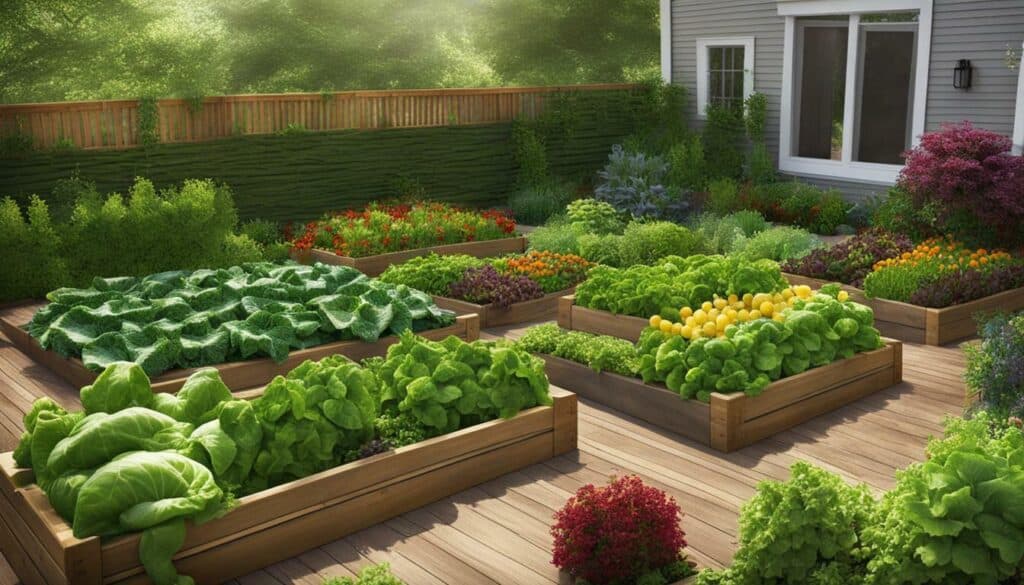
Designing Your Raised Bed Garden
Designing your raised bed garden can be a fun and creative process, with various tutorials and designs to inspire you. One popular design is the square foot gardening method, which involves dividing the bed into equal sections for efficient planting and spacing. This method is particularly useful for small raised garden beds, allowing you to maximize your growing space.
If you’re looking for a more aesthetic approach, raised garden bed design can be a way to elevate your garden’s appearance. Some popular designs include circular or hexagonal-shaped beds, or incorporating decorative elements such as trellises or garden art. The possibilities are endless, so don’t be afraid to get creative!
When it comes to selecting a suitable raised garden bed tutorial, there are numerous resources available online and in-store. Look for tutorials and step-by-step guides that align with your gardening preferences and level of expertise. For beginners, it’s important to start with simple designs that are easy to assemble and maintain.
Remember to also consider the practical elements of design, such as the height and width of the bed. Raised beds should be at least six inches deep to allow for root growth, with a width that allows for comfortable access from all sides. You can also add features such as built-in benches or seating to further enhance your gardening experience.
Finally, don’t forget to choose materials that are both practical and aesthetically pleasing. Wood is a popular choice for its natural look and ease of assembly, while concrete blocks offer durability and flexibility in design. Metal beds are another option for a modern look, while using recycled materials can be an eco-friendly choice.
With a little creativity and planning, designing your raised bed garden can be a rewarding and enjoyable process. Not only will you have a beautiful and productive garden, but you’ll also have the satisfaction of growing your own fresh and nutritious produce.
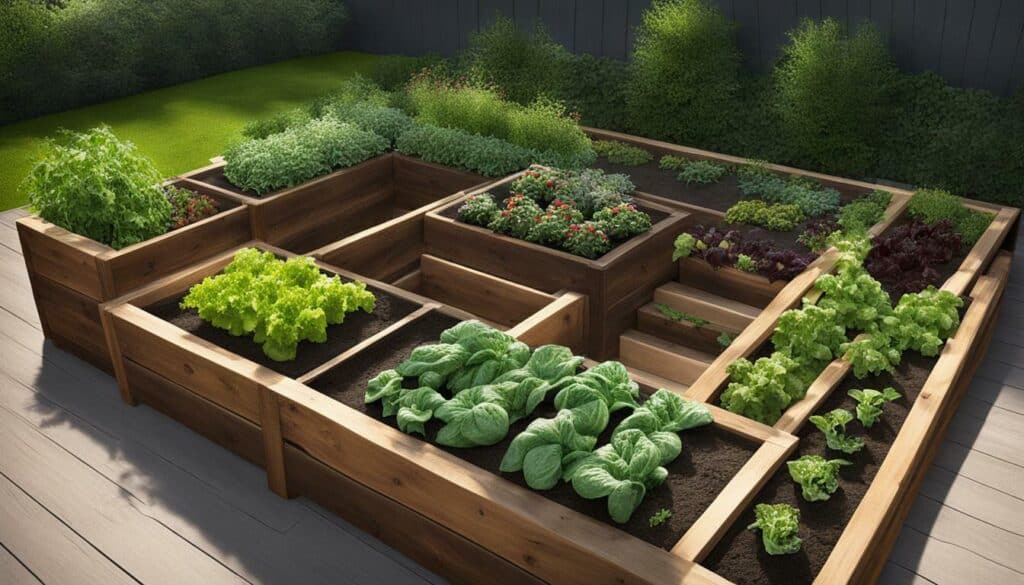
Extending the Growing Season
Raised bed gardening is applicable to all US climates and offers techniques for extending the growing season. By creating elevated planting areas, gardeners have complete control over the soil composition and can create a fertile and well-draining environment, which allows for improved soil quality, better drainage, and easier weed and pest management. The soil in raised beds also warms up quickly in the spring and retains heat better, which extends the growing season for regions with shorter seasons or cooler climates.
One way to extend the growing season is to use row covers or cloths to protect plants from frost. These materials can increase the temperature inside the bed by several degrees, allowing for earlier planting and later harvesting. Another technique is to use cold frames or hoop houses to provide a protected environment for plants during cooler months.
Additionally, choosing the right plants and timing the planting can also help extend the growing season. Certain vegetables like lettuce, broccoli, and kale can tolerate cooler temperatures and can be planted early in the spring or late in the fall for a longer growing season.
Overall, raised bed gardening offers a fantastic opportunity for gardeners of all levels to experience thriving and bountiful gardens while extending the growing season. With the right techniques and care, you can enjoy fresh and delicious produce for a longer period of time.
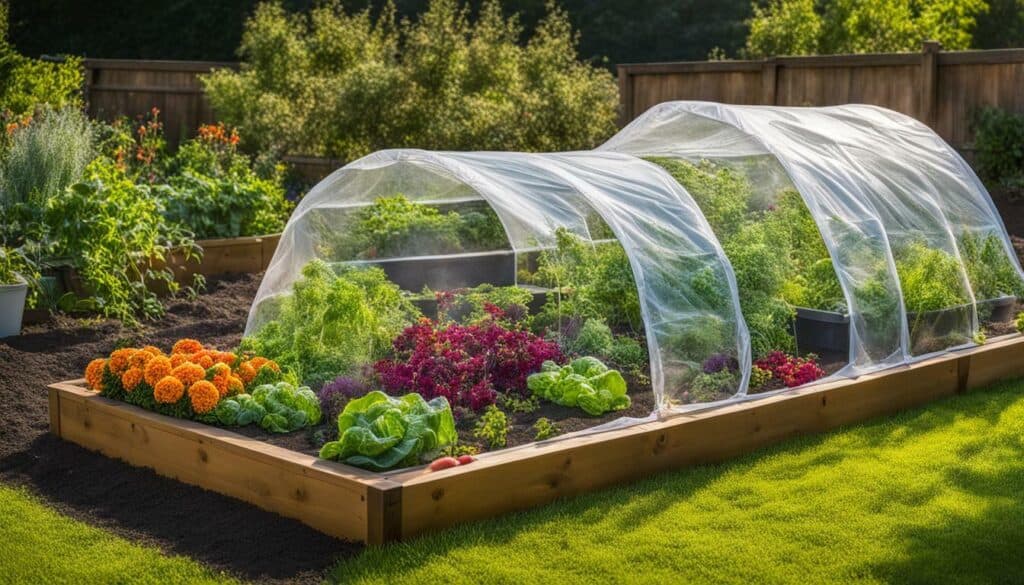
Troubleshooting Common Issues
Like any gardening method, raised bed gardening may have its challenges, but common issues can be easily addressed. Some of the most common issues that gardeners may encounter include soil problems, watering difficulties, and pest management.
| Common Problem | Troubleshooting Solution |
|---|---|
| Soil Quality | Use high-quality soil, compost, and organic matter to create a fertile and well-draining environment. |
| Watering Difficulties | Consistent watering, especially during hot and dry periods, is important to prevent dehydration of plants. |
| Pest Management | Implement techniques such as mulching and companion planting to manage pests. Rotate crops annually and replenish soil with compost and organic matter to prevent soil-borne diseases. |
By addressing these common issues, gardeners can ensure the continued health and productivity of their raised bed gardens. With a little troubleshooting and attention to detail, raised bed gardening can be a successful and rewarding experience.
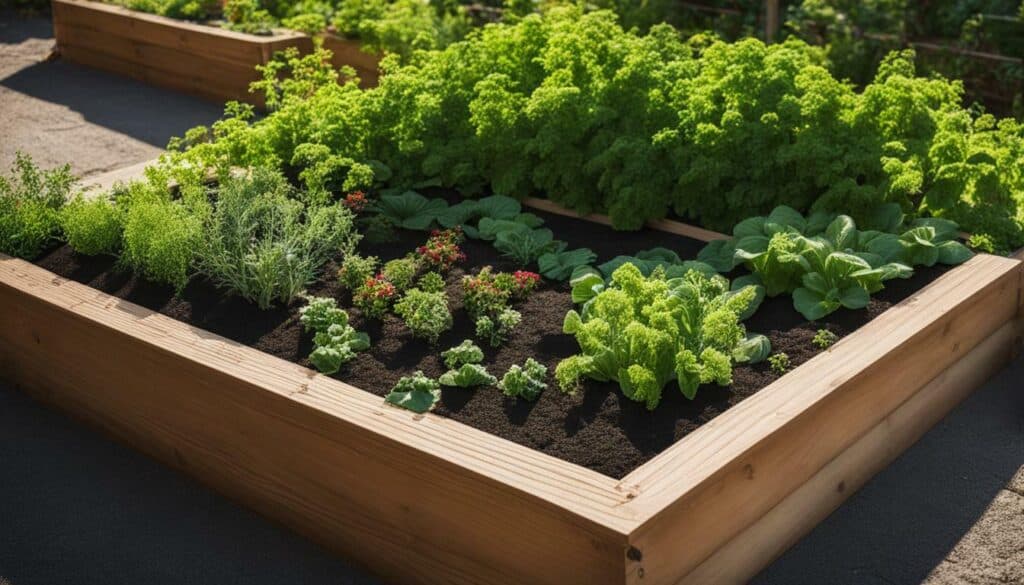
Can I Use Raised Garden Beds for Organic Gardening?
Using raised garden beds for organic gardening is a great way to grow your own produce without harmful chemicals. These beds allow you to control the quality of soil and drainage, which is vital for a successful organic garden. To get started, master organic gardening basics today and reap the benefits of fresh, chemical-free fruits and vegetables.
Conclusion
Raised bed gardening is a rewarding and accessible way to cultivate a thriving garden. The benefits of raised bed gardening, including improved soil quality, better drainage, easier weed and pest management, and extended growing seasons, make it an excellent choice for beginners and experienced gardeners alike.
When starting a raised bed garden, it is essential to select a suitable location, create well-draining soil, and choose appropriate plants. Proper care practices such as regular watering, mulching, and crop rotation will help ensure a healthy and productive garden.
With raised bed gardening, even those with limited space or mobility can enjoy growing vegetables and plants at home. The customizable designs and various materials available make it easy to create a garden that fits your unique needs and preferences.
Whether you’re looking to start a new garden or improve the productivity of an existing one, raised bed gardening is a great option to consider. With careful planning and maintenance, you can enjoy a bountiful harvest and the satisfaction of growing your own food with a basic raised garden bed.
FAQ
Q: What are the benefits of raised bed gardening?
A: Raised bed gardening offers improved soil quality, better drainage, and easier weed and pest management.
Q: How do I start a raised bed garden?
A: To start a raised bed garden, choose appropriate plants for your climate and select a suitable location.
Q: What materials can I use to build a raised bed?
A: You can build a raised bed using various materials such as wood or concrete blocks.
Q: What kind of soil mix should I use for my raised bed?
A: It’s important to create a well-draining soil mix for your raised bed.
Q: How do I care for my raised bed garden?
A: Regular watering, mulching, and crop rotation are essential for maintaining a healthy raised bed garden.
Q: How can I maximize yield in a small raised bed garden?
A: There are tips and techniques for maximizing productivity in a small raised bed vegetable garden.
Q: Are there any tutorials or design ideas for raised bed gardens?
A: Yes, you can find tutorials and creative designs to help you design your raised bed garden.
Q: Can raised bed gardening be done in all US climates?
A: Yes, raised bed gardening is applicable to all US climates and can help extend the growing season.
Q: What are some common issues in raised bed gardening?
A: Common issues in raised bed gardening include pest infestations and nutrient deficiencies, but there are troubleshooting solutions available.
Q: Why should I consider raised bed gardening?
A: Raised bed gardening is a beginner-friendly and accessible way to cultivate a thriving garden, even for those with limited space or experience.
Source Links
- https://greenerimage.com/blogs/gardening-homegrowing/everyone-can-learn-to-have-a-green-thumb
- https://www.ollegardens.com/blogs/olle-garden-tips/learning-to-garden-in-raised-beds-improve-your-green-thumb
- https://www.amazon.com/Raised-Bed-Gardening-Beginners-Successfully-ebook/dp/B093298WCG
- https://www.amazon.com/INTRODUCTION-RAISED-BED-GARDENING-SUSTAINING/dp/B08FV3B21F
- https://www.finegardening.com/article/the-benefits-of-raised-garden-beds
- https://www.gardenary.com/blog/the-complete-guide-to-raised-beds
- https://www.gardenary.com/blog/3-reasons-raised-beds-are-better-for-gardening
- https://www.almanac.com/content/how-build-raised-garden-bed
- https://joegardener.com/podcast/raised-bed-gardening-pt-1/
- https://www.gardeners.com/how-to/raised-bed-basics/8565.html
- https://www.loveandrenovations.com/how-to-build-a-diy-raised-garden-bed/
- https://abeautifulmess.com/make-your-own-raised-garden-bed-in-4-easy-steps/
- https://miraclegro.com/en-us/projects-planning/how-to-care-for-plants-in-a-raised-bed.html
- https://all-americaselections.org/how-to-raised-bed-garden-care/
- https://umbelorganics.com/maximize-small-garden/
- https://miniurbanfarm.com/how-to-max-out-a-small-garden/
- https://www.veggums.com/learn/gardening/maximizing-yield-in-small-vegetable-garden/
- https://www.gardendesign.com/vegetables/raised-beds.html
- https://www.thespruce.com/raised-bed-garden-ideas-4172154
- https://www.gardeners.com/how-to/season-extending-techniques/5063.html
- https://learn.eartheasy.com/articles/7-ways-to-extend-the-growing-season/
- https://permies.com/mobile/t/76862/raised-beds-prolong-growing-season
- https://journeywithjill.net/gardening/2020/10/20/problems-with-raised-bed-soil-how-to-troubleshoot-and-revive-a-raised-garden-bed/
- https://www.bhg.com/gardening/how-to-garden/raised-bed-garden-mistakes/
- https://journeywithjill.net/gardening/2018/02/13/7-common-mistakes-in-raised-bed-gardening/
- https://extension.missouri.edu/publications/g6985
- https://www.gardenfundamentals.com/raised-beds-pros-cons/
- https://extension.unr.edu/publication.aspx?PubID=3180

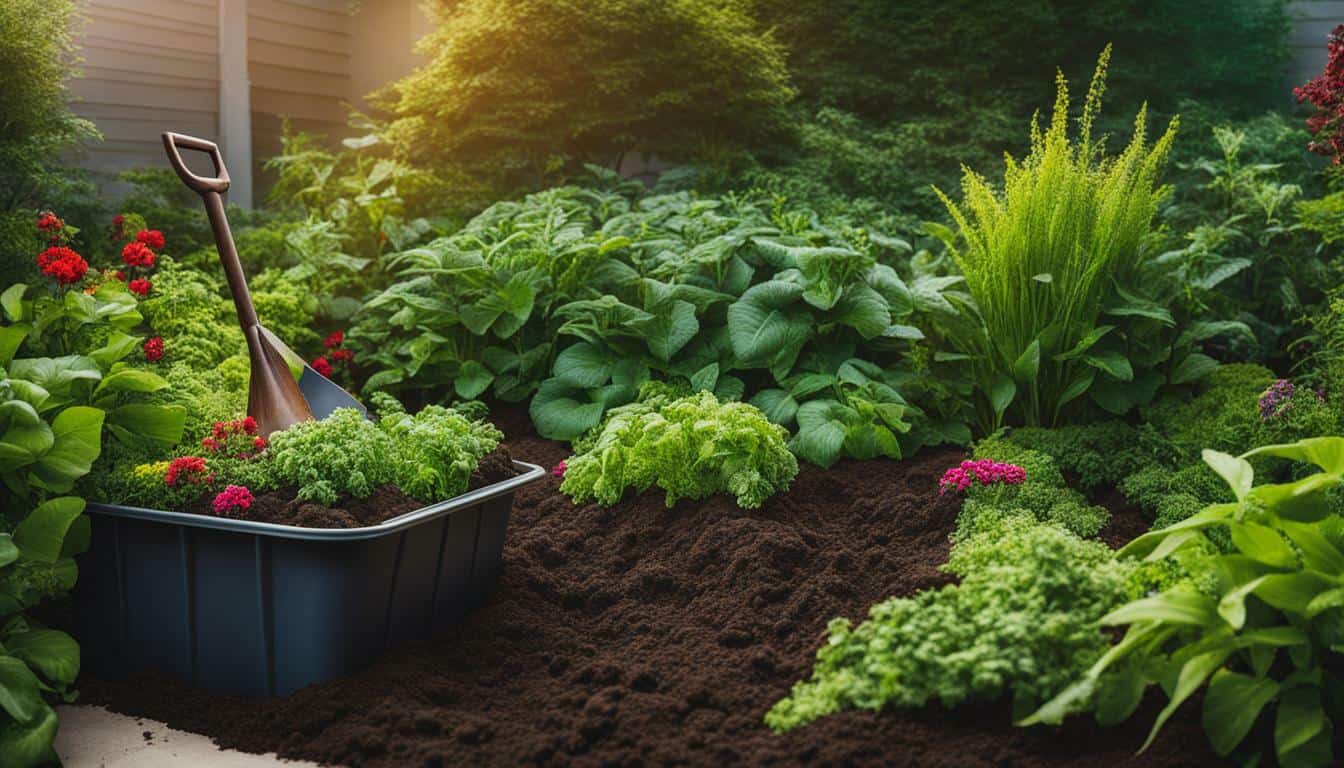



Leave a Reply